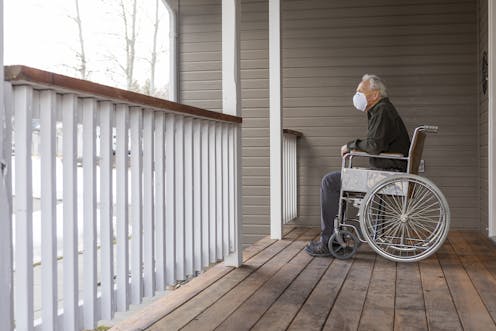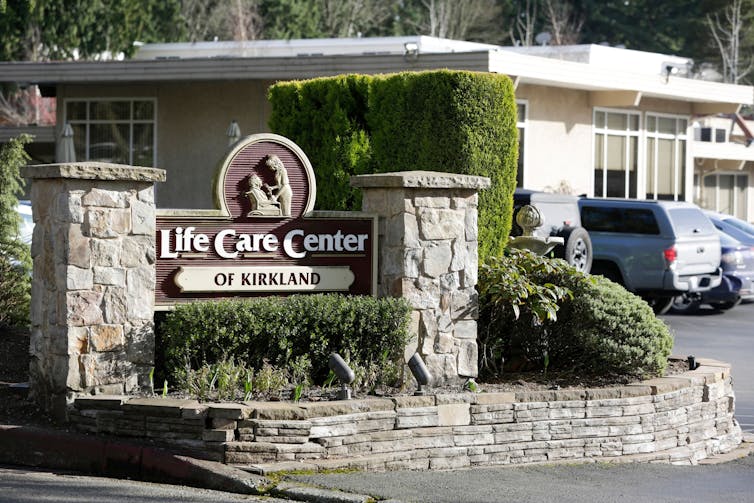Even before COVID-19, US nursing homes were filling empty beds with psychiatric patients
A neuropsychologist who works in these skilled care facilities describes the changing populations. With COVID-19, many nursing homes are now struggling to stay in business.

One year ago, a nursing home in Kirkland, Washington, became an early battleground for the U.S. coronavirus outbreak. The disease has since decimated nursing home populations – more than one-third of the COVID-19-related deaths in the U.S. have been nursing home residents and staff. Virtually unnoticed is what has followed: In some nursing homes, a shift has occurred in the type of residents who live there, and COVID-19 is one of the reasons.
As older residents die from the pandemic and as more families choose to keep elderly relatives at home, some of these facilities are accepting more younger patients, including some with drug addictions and mental illness. Some patients have schizophrenia. Some have psychosis. This change in clientele can have a dramatic impact on the daily functioning of nursing homes, a change that administrators and staff may be unprepared to handle.
As a neuropsychologist who has been working in skilled care facilities for more than 25 years, I have seen this transition up close. The migration of psychiatric patients to these facilities began in the 1950s, then sped up in the 1980s, when state psychiatric hospitals began rapidly shutting down. Today, about 95% of these hospitals are closed. The ones still open hold collectively about 37,000 beds, nearly 90,000 short of what’s needed.

Bringing in younger psychiatric patients
Primarily because of the deaths caused by the pandemic, many nursing homes now have lots of empty beds. And to put it bluntly, they need money to survive. The National Health Care Association and National Center for Assisted Living estimate the U.S. long-term care industry will see a 16% drop in revenue in 2021 and some 1,670 closures or mergers. In some states, nursing homes can be penalized with Medicaid funding cuts if their occupancy drops too low.
Even many high-end nursing homes, once solicitors of only the affluent, have been taking younger patients, some in their 30s and 40s, most who have only Medicaid.
These younger patients often have coexisting conditions: substance abuse problems along with psychiatric illnesses. Some have lost contact with their families. Some are without income; others are on disability. Often, they have no place to go. Even for those getting help from their families, the cost of extended care is not affordable, nor can families provide the care themselves. Although estimates vary widely, the best assessment suggests more than 125,000 young and middle-aged adults, most with mental illness, lived in nursing homes before the pandemic.
While federal law requires alternatives to this type of institutionalization for younger patients who spend years in a nursing home, implementation of these laws varies from state to state. Insurance companies often prefer nursing homes as a more cost-effective option than in-home or supervised care, especially for those with severe mental illness. But putting psychiatric patients near elderly and infirm residents can cause problems. Active drug addicts may seek medications, particularly opiates. Active psychotics can be volatile, even violent. These patients may live in nursing homes for years and eventually saturate the facility with a significant psychiatric population.
The staff members at these homes often don’t know how to care for this kind of patient. They need training similar to what’s given at psychiatric hospitals. Instead, they can become overwhelmed. They deal with behavioral issues, including assaults. Behavioral health nurses have the highest turnover rate among nursing specialties. One-third of them quit within two years.
For nursing home administrators, this is just one more confounding problem they face. COVID-19 has been a devastating experience for them. The virus has ravaged their facilities. One administrator told me she lost nearly one-third of her residents to this illness. I could relate – more than 100 of my patients have died from COVID-19 in the last year.
A tremendous emotional toll
Certainly, death is always a presence in a nursing home. But the sheer number of deaths due to the pandemic has been staggering. Death, grief and fear are not a good psychological cocktail. The emotional toll on workers is tremendous, and with COVID-19, the already high employee turnover rate has climbed. Three administrators told me more than a quarter of their staffs have quit. Many are nursing aides, making barely above minimum wage and justifiably terrified at the prospect of catching a virus that could be lethal. These aides are often the only ones there to hold the hands of patients as they die.
Residents who survive the pandemic have endured tremendous hardships. To be stuck in your room, mostly alone, for a year can be profoundly depressing. Friends die and are removed in the middle of the night. Those who remain, some with dementia, may think their friends and family have abandoned them. Residents testing positive for COVID-19 are generally moved to a different part of the home, which is unsettling for them and increases their confusion and mood swings.
Finding housing solutions benefiting both psychiatric patients and an elderly population is a long-haul problem. Money is one of the answers; the National Alliance on Mental Illness has lobbied Congress for more. In particular, funds are needed for group homes where residents with mental illness can eventually transition back to the community. The Department of Housing and Urban Development offers programs that help the elderly and those with disabilities get safe, decent housing. Generally, a person must receive Medicaid to qualify for these services, and demand for any of these alternatives far exceeds availability.
[Over 100,000 readers rely on The Conversation’s newsletter to understand the world. Sign up today.]
At least the immediate future at many nursing homes is looking better. Many of my patients have been vaccinated. Death rates are dramatically lower. Facilities now allow family to visit, albeit with strict protocols. Soon residents will be able to socialize with each other again. Still, the pandemic’s toll on residents, families and staff will linger for years. The year 2020 has traumatized many of us, including me.
Don Martin does not work for, consult, own shares in or receive funding from any company or organization that would benefit from this article, and has disclosed no relevant affiliations beyond their academic appointment.
Read These Next
How the NIH became the backbone of American medical research and a major driver of innovation and ec
The agency’s budget has grown steadily since the 1960s, fueling an industry that creates lifesaving…
Best way for employers to support employees with chronic mental illness is by offering flexibility
Employers that don’t support employees with mental illness risk missing out on the talents and skills…
How are dark matter and antimatter different?
Normal matter – which makes up everything we see and touch – isn’t the only type of matter present…





